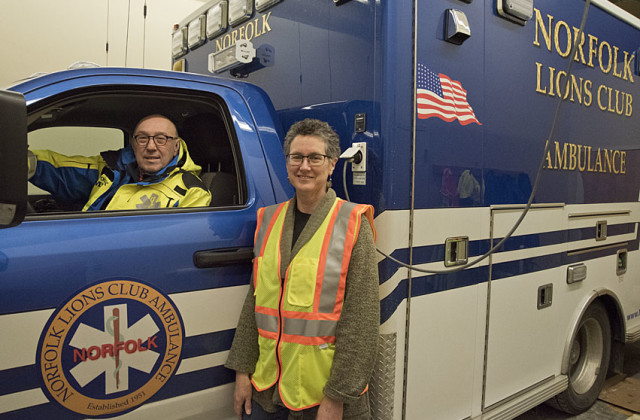The Thin Red Line of Volunteers
Norfolk Lions Club Ambulance
By Doug McDevitt
Photo by Bruce Frisch
The anticipated knock at the door was greeted with a quick step while the guests were greeted with smiles and the aroma of roast turkey, stuffing and fresh baked pies. Mouths were watering on both sides of the door as family and friends were reunited at the home of Kitty Hickox and her husband, Dan Wuori, for a Thanksgiving feast. The table was set in a beautiful display of china, food and holiday decor as everyone took their seats, when the sudden shrilled alarm of a portable radio pierced the air. Startled guests looked up in confusion, but Hickox and Wuori glanced at each other with knowing dread as the message of a car accident was broadcast. A family somewhere was not going to have a happy holiday, and Hickox, who is chief of the Norfolk Lions Club Ambulance (NLCA), jumped to her obligation and was out the door as the last words of her apology reached her guests at the table. The scene above was invented, but similar scenes have occurred to almost every Norfolk ambulance volunteer.
Many of us take everyday events for granted without having to think about Murphy’s Law, but our ambulance service in town does not have that luxury. We can all go about our daily routines knowing that 18 certified Emergency Medical Technicians and additional support personnel are ready to respond when we are in great need. But alas, so are they. The Norfolk ambulance service was formed by the Lions Club in 1957 and has been diligently serving our community ever since at no cost. The NLCA will never send a bill for their services. And they raise the funds for the ambulance vehicle on their own. They are led by Chief Kitty Hickcox and Deputy Chief John Riedeman. While motor vehicle accidents do occur, Hickcox explained that more than half of ambulance calls are non-high stakes events and quite often just a question of providing a hand to hold. But even that requires training. A certified EMT, or Emergency Medical Technician, must be 16 years of age, complete a minimum of 200 hours of training and pass a certification exam. An EMR, or Emergency Medical Responder, must be 14 years of age and complete a minimum of 60 hours of classes. EMR’s are trained to support the EMT’s. The training must be paid for, but the NCLA is happy to partner and offset the cost by 50 percent; scholarship funds are also available at Northwestern Community College. NLCA operates on a tight budget of $32,000 a year, which is quite amazing considering a typical full-service ambulance crew operates at around $250,000, so donations of any kind are very welcome, just contact the Norfolk Lions Club.
Training is ongoing at NLCA. In addition to the required re-certifications, mock car extractions, training with the Lucas device—a mechanical chest compression machine—and “hide-n-seek” trail rescues, where NLCA places a lost or injured actor somewhere in our trail system to be found and administered to, many other programs are conducted routinely. Hickcox says that a number of the ambulance’s younger member gain significant life skills, including dealing with high-stress situations and learning to communicate effectively in those unique conditions. Many NLVA graduates have gone on to careers in the medical field, the military or the business world and reference their time as volunteers with NLCA as contributing to their success.
NLCA is there to serve us but they need your help. The biggest need currently is for EMT personnel, but all other positions including EMR’s and drivers are welcome. Hickcox says the ambulance corps is looking for one to 12 hours of service per week, especially for daytime shifts. If you would like to be a part of this outstanding group of first responders, contact Kitty Hickcox at 860-751-2864. They are there for us; can we be there for them?

